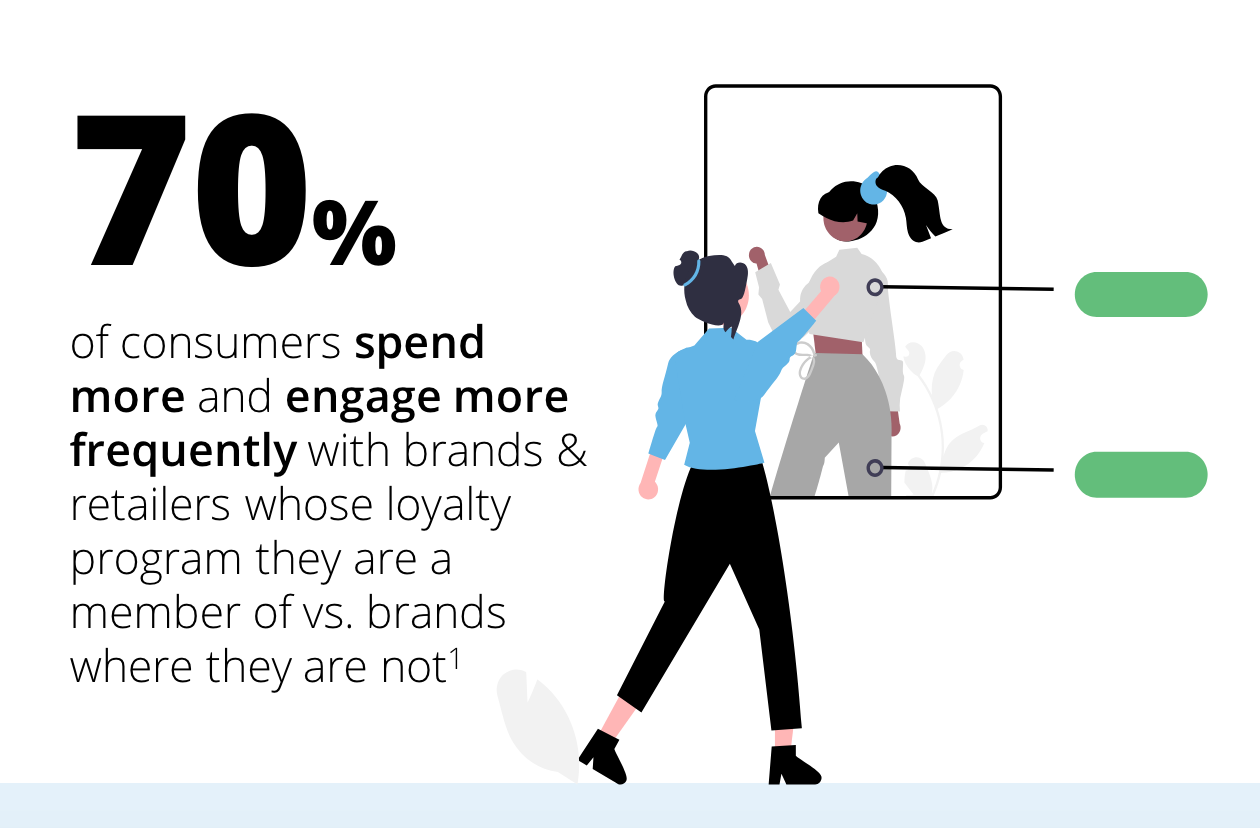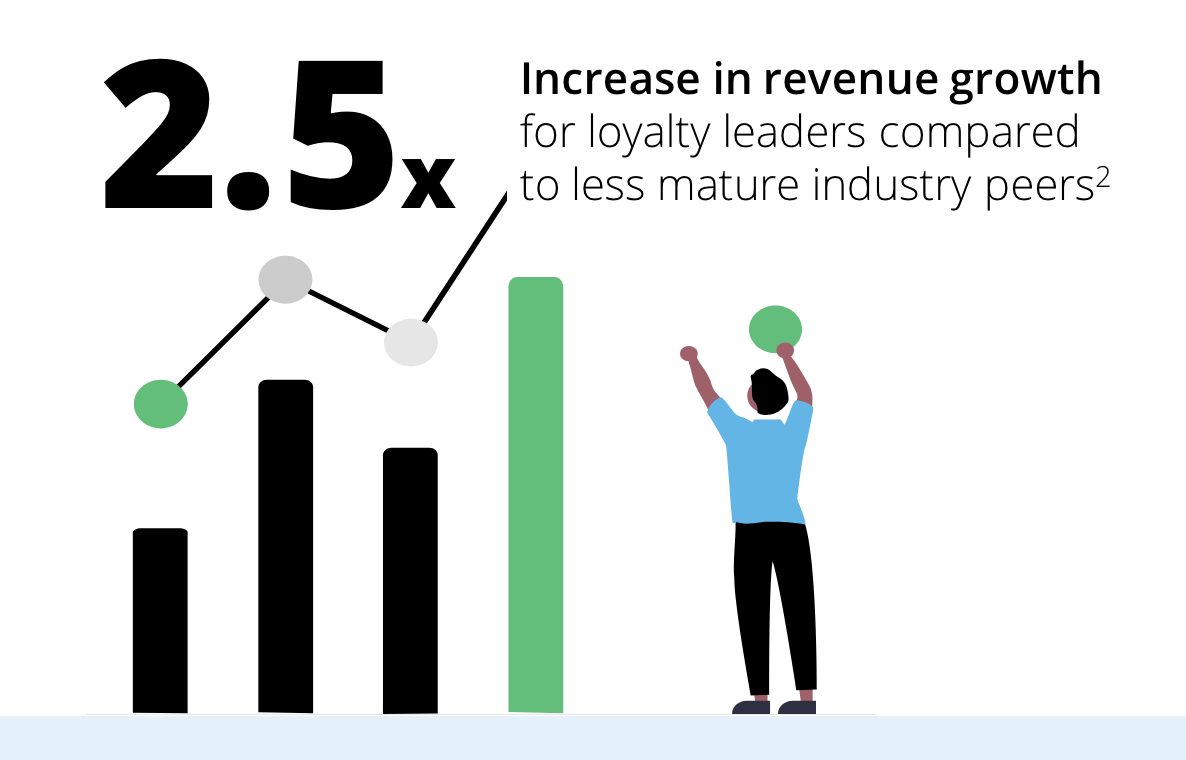We probably don’t need to tell you how important customer loyalty is.
Loyal customers tend to spend more per purchase, buy more frequently, and have better retention rates. Loyal customers are also more likely to become brand advocates and share your business with others.
But how can you tell what makes your customer base loyal?
Customer loyalty analytics can provide a wide range of data on engagement, repeat purchase rate, customer retention rate, and more for all the insights you need.
Understanding the Importance of Customer Loyalty
Customer loyalty has historically been one of the most critical factors to long-term business success. For perspective, consider these statistics.
“70% of consumers spend more and engage more frequently with brands and retailers whose loyalty program they are a member of.”
 Image Source: Deloitte
Image Source: Deloitte
There’s an 82% chance that a customer will buy again or renew their service with an existing brand they’re loyal to when given the chance to switch to a competitor.
And there’s a 97% chance that a loyal customer will share a brand with others through positive word-of-mouth.
Not to mention, loyal customers are more likely to stick around longer for better retention, and you don’t have to spend as much on marketing to continually find new customers if you’re able to retain a large percentage of existing ones.
Once you fully understand the vital importance of customer loyalty, you’ll want to do everything you can to objectively analyze and increase it, which brings us to the main point of this article — using customer loyalty analytics.
Utilizing Data Analytics to Track Customer Behavior
Hands down, the best way to objectively assess customer behavior to understand customer loyalty is with predictive analytics. This offers a detailed overview of every customer interaction throughout the retail customer journey.
From the moment someone first learns about your brand to when they become a new customer to when they make a purchase to when they become a repeat customer to when they enroll in your loyalty program, the loyalty data that’s generated offers everything you need to know.
Some specific metrics you can measure with customer loyalty analysis include:
- Website visits
- Purchases
- Purchase frequency
- Average purchase value
- Repeat purchase rate
- Support tickets
- Customer retention rate
- Customer lifetime value
- Customer feedback
- Customer Satisfaction Score
- Net Promoter Score
Basically, any aspect of customer engagement, pre- or post-purchase, can be measured with customer loyalty analytics to help you clearly understand what contributes to customer loyalty.
In turn, you can make data-driven decisions with sales, marketing, and customer service to increase the odds of retention and each person becoming a loyal customer.
Creating Targeted Marketing Campaigns
We just mentioned that the customer data generated through customer loyalty analytics can benefit multiple departments within your company, including sales, marketing, and customer service.
But let’s zero in specifically on how customer loyalty data assists in creating targeted marketing campaigns, as this is how you find new customers to begin with.
A simple example is looking at customer analytics data to determine which products are most popular among existing customers and which advertising channels are driving the most signups.
 Image Source: Woopra
Image Source: Woopra
Once you know what’s working in these areas, you can offer deals and discounts on your most popular products on the advertising platforms that get the biggest results.
That way, you’re not only able to generate more quality leads and convert more customers, you’re more likely to build stronger customer relationships along the way.
As a result, this can lay the groundwork for increased customer satisfaction, greater customer retention, longer customer lifetime value, and a stronger customer loyalty program.
Improving Customer Experience
Knowing which factors contribute to a positive customer experience, as well as what’s harming the customer experience, is crucial to gaining more loyal customers. It’s all about using concrete loyalty data rather than merely speculating.
A good example of how you can improve the customer experience with loyalty analytics is by seeing where you’re losing customers during onboarding.
 Image Source: Woopra
Image Source: Woopra
If there’s a clear area where you’re seeing way more drop-off than you should, that’s where you would want to focus your attention.
By fixing that, you could improve onboarding to create better customer satisfaction and set the tone for increased retention and customer loyalty.
Or, you could use customer loyalty analytics to gain insight into how support tickets affect your Net Promoter Score.
 Image Source: Woopra
Image Source: Woopra
If your current support ticket process is resulting in a high Net Promoter Score, that’s good. But if it’s leading to a low Net Promoter Score, it’s an area that would need your attention.
Once you improve support tickets, higher customer satisfaction should follow, as well as greater customer loyalty.
Strengthening Customer Relationships for Increased Profitability
The correlation between loyal customers and greater earnings is undeniable. To quantify, loyalty leaders see an average revenue growth of 2.5x more than competitors that lack a solid loyalty program.
 Image Source: Deloitte
Image Source: Deloitte
By understanding the nuances of customer behavior and what makes loyal customers tick, it puts you in a position for building stronger relationships.
For instance, when you use customer data to understand the preferences, interests, frustrations, and concerns of your existing customers, you can adjust your strategies to better cater for their needs.
From customer segmentation to marketing to sales to customer support and beyond, you can operate with certainty to facilitate streamlined relationship building.
And as we’ve mentioned, this naturally leads to increased profitability because your customers are likely to make more purchases, spend more, and stay with your company longer.
Frequently Asked Questions
How can customer loyalty analytics be used to improve employee satisfaction?
Customer loyalty analytics data can be used to pinpoint specific areas where employees need to focus their attention, how to best connect with customers, and how to make customers happy.
In turn, this makes the employee experience easier, which can raise collective satisfaction levels.
What ethical considerations should businesses keep in mind when collecting and analyzing customer data for loyalty programs?
Customer privacy and transparency are the two biggest concerns with a customer loyalty program.
Like with any form of customer analytics where a large volume of data is gathered, it’s critical that you take proactive measures to prevent data breaches and let customers know how you’re using their data to enhance the customer loyalty program experience.
Are there any industries or businesses that are not suitable for customer loyalty programs?
If you only have one-time sales where a customer buys and is done (think real estate financial services or luxury auto sales), a customer loyalty program probably won’t make sense.
Can customer loyalty analytics be used to predict future trends and behaviors in the market?
Yes, most definitely. Loyalty analytics is an extremely helpful tool for predicting future trends and behaviors. After all, analyzing past patterns and trends is one of the best ways to predict how customers will behave in the future.
If you’re interested in using analytics to improve other areas of business, we suggest checking out these articles:
- Customer retention analytics
- Customer data analytics
- Customer insights analytics
- Customer journey analytics
How can businesses measure the success of their customer loyalty programs beyond just increased profits?
Customer engagement, purchase frequency, repeat purchase rate, customer retention rate, customer churn, customer lifetime value, and Net Promoter Score are excellent KPIs to determine the success of a customer loyalty program.
These go more granular and should provide valuable insight into loyalty program performance.
Conclusion
Increasing brand loyalty is the ultimate way to help your brand across the board. The quickest way to raise loyalty is to use customer loyalty analytics to understand the customer journey flow holistically.
Armed with this data, you can address weak areas and double down on what’s working with your loyalty program to bring customer loyalty to its optimal level.


